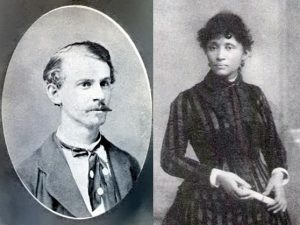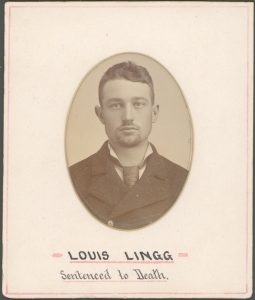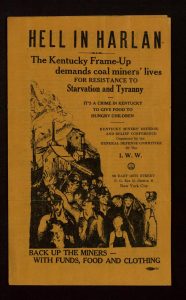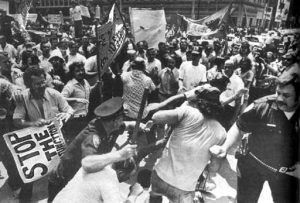Filed under: Anarchist Movement, Anti-fascist, Editorials, Featured, US, White Supremacy

May Day is International Workers’ Day
May Day, first of May, is International Workers’ Day. Fighting workers the world over stand together and in solidarity on May Day. We remember May 1, 1886, the day workers across the U.S. went on general strike to demand and to implement the 8 hour day. Hundreds of thousands of workers struck on that day. Labor unions and central labor councils in many cities supported the strikes, and the movement was strongest in Chicago.
Anarchists around the country, but especially in Chicago, were in the forefront of this strike and the struggle for the 8 hour day. In 1881, workers from many countries had formed the International Working People’s Association (IWPA), known as the Black international, the anarchist international
Workers and anarchists from the U.S. joined the IWPA, but there were two currents or approaches within the IWPA in the U.S. and other countries. One wing was Individualist anarchists, who believed in propaganda by the deed and opposed participation in what they described as reformist struggles. Another wing, including the Chicago anarchists, did believe in participating in workers’ struggles, in the developing labor movement and in the struggle for the 8 hour day. Albert Parsons, Lucy Parsons, August Spies and others had to convince some of their fellow anarchists that it was necessary for the developing anarchist movement to be based in the working class and the struggles of the working class. As a result, anarchists were in the forefront of the struggle for the 8 hour day in Chicago and elsewhere. These anarchists, who we remember every May Day, urged workers to organize, to strike, to use the general strike and direct action to win the 8 hour day, and they urged workers to arm themselves and to defend themselves against police, employer and scab attacks.
In Chicago, on May 1, Lucy Parsons and Albert Parsons and other anarchists marched with 40,000 striking workers to demand the 8 hour day. On May 2, Chicago anarchists joined with the McCormick Harvester strikers. August Spies, an anarchist, spoke at the rally urging the strikers and supporters to fight back and defend themselves against scabs and police who were mobilizing to attack the strikers. The police and strikebreakers did attack the rally, killing two striking workers and injuring many more. On the next day, anarchists called a meeting at Haymarket Square in Chicago to protest against the police murders of striking workers. Albert Parsons, August Spies and other Chicago anarchists spoke at the rally. Toward the end of the rally, police charged the protest to break it up. A bomb was thrown into the police; one policeman was killed, others were injured, and six more police died from injuries.
No one was ever charged with throwing the bomb, but Albert Parsons, August Spies and six other Chicago anarchists were charged with conspiracy and put on trial for murder. The state didn’t claim that the Chicago anarchists had thrown the bomb; they put anarchism and anarchist organizers on trial for being revolutionaries. All eight anarchists were convicted and five were sentenced to death. Albert Parsons, August Spies, Adolph Fischer, George Engel were hanged by state of Illinois in 1887. Louis Lingg, also sentenced to hang, committed suicide on the night before the scheduled executions.
The ruling class killed the Chicago anarchists and attacked anarchists’ offices and newspapers and organizations. The rulers feared anarchism and the influence of the anarchists and the revolutionary approach of the anarchists as part of the working class movement, the growing union movement and the struggle for the 8 hour day. The ruling class killed the Chicago anarchists, because these anarchists were dangerous. The anarchists understood that revolutionaries could not stand aside from the workers’ struggles, could not stand aside from the movement for the 8 hour day. The anarchists understood that the way to build the revolutionary movement and the international anarchist movement was through direct participation in the struggles of working people. They understood that anarchists could not look down at reformist struggles, but instead should build and participate in these struggles and convince workers of the need for anarchism and revolution by the lessons learned in these joint struggles. The anarchists were in the forefront of the fight and the strikes for the 8 hour day. The anarchists were in the forefront of the growing union movement and were urging workers to defend themselves and to prepare for revolution. This is why the ruling class killed them.
Louis Lingg, 21 year old Haymarket Martyr, said this in his final statement to the court which had ordered his execution: “ I repeat that I am the enemy of the ‘order’ of today, and I repeat that, with all my powers, so long as breath remains in me, I shall combat it … I despise you. I despise your order; your laws, your force-propped authority. Hang me for it!”
The rulers killed the Haymarket anarchists in 1887, 130 years ago. It’s important that we understand, today, the lessons that Haymarket teaches us. Revolutionary anarchists should participate in and be in the forefront of the struggles of working people and in defense of communities under attack, whether these struggles are revolutionary or reformist, whether it’s a general strike for shorter hours or the struggles to build unions and workers’ organizations or the defense of a Mosque or to oppose a deportation raid or join in struggles against police attacks. As working people and as revolutionary anarchists, we must organize to defend ourselves and our communities.
There is another important lesson we learn from the Haymarket martyrs. The anarchists in Chicago and in the International Working People’s Association (IWPA) organized all workers: skilled and unskilled, women and men, Black and white, recent immigrants and all nationalities. They opposed white supremacy and urged a united working class struggle and built united working class organizations and unions. The Chicago anarchists were active members of the IWPA, the anarchist international, which united workers and anarchists across all borders. This, too, is why the rulers killed them. These were dangerous and effective ideas, and broader sections of the working classes were taking up these ideas around the country and throughout the world.
Pikeville
There is today a fascist named Matthew Heimbach, , of the “Traditionalist Workers Party,” who is calling for fascists and white supremacists to gather in Pikeville, Kentucky the weekend of April 28 and for “white workers to take back May Day.” Heimbach has no knowledge of or denies the actual history of May Day as International Workers Day. He claims white workers should support white supremacy and beg the rulers for blessings because they are white. Heimbach also claims white workers should look out only for themselves and attack Muslims, Jews, immigrants, Black workers, Latinx workers, Indigenous peoples and Asians. These fascists say women are inferior to men and that being gay is an abomination and white people cannot date or marry anyone other than another white person. These fascists oppose freedom and believe they have the right to impose their vision of white supremacy and patriarchy on the rest of us.
We support anarchists and revolutionaries going to Pikeville at the end of April to oppose these fascists and to commemorate May Day, International Workers’ Day. And we go to Pikeville to organize with working people in Pikeville and from surrounding communities to oppose fascism and to build a united working class struggle for freedom and revolution. We honor the heroic struggles of coal miners and their families in Pikeville and Harlan County and Mingo and Logan counties in West Virginia and throughout the region. From the 1890’s through the early 1900’s through the battle of Matewan and the struggle of thousands of armed miners at Blair Mountain in 1921, through the battles to build the union in the 1930’s and up through the Harlan County strike in the 1970’s and beyond, miners and miners’ families throughout the coal fields of Eastern Kentucky and West Virginia have participated in some of the most militant struggles in the history of workers in this country.
The ruling class, the capitalists, and their agents are attacking the entire working class in the search for more profits and to defend and protect their power and wealth. These are attacks on working people around the world. Austerity, growing fascist movements, attacks on “the other,” are not just in the U.S. but are worldwide. And in the U.S. cities are under attack, schools are under attack, poor people are under attack. There are attacks on Muslims and immigrants and Latinx communities. There are increased police attacks on Black communities. And for all us, it’s fewer jobs and lower wages and cuts in benefits and failing health care and ongoing attacks on the planet. These attacks hit all working people in the U.S., including white working people and all poor people.
These attacks also hit folks who considered themselves to be middle class or who had skilled jobs and earned enough to live what was considered a “middle class’ lifestyle. These folks, many of them white, also are under attack and losing ground and worried about the future. The ruling class hits the middle class and better off workers and grinds us all down. Trump tells these folks to stick with him and make America great again by making America white again and attacking the “other.” Heimbach says these white folks should join the fascists and present themselves to the rulers as a force to oppose and attack the working class and to divide the working class and to attack the fighting organizations of the working class and the oppressed. Heimbach says white workers should be loyal to the rulers and the system and put their lives on the line to protect the wealth and the power of the ruling class, protect the very system which grinds them down and act as the ultimate scabs on the rest of the working class.
We say white workers and all workers should face reality. There is one working class, and we are all in it. We are under attack by the rulers and the capitalist class and their system. They are moving to broader wars and more dangerous confrontations. They are moving to increasing nationalism and patriotism and authoritarianism. The rulers and the corporations double down on destruction of the environment and the planet in order to protect and increase their power and privilege and profits. And the rulers use their government to deflect anger away from the billionaires and their system by scapegoating and attacking Muslims, the Latinx community, immigrants, refugees, the Black community and poor people and marginalized communities. It’s deportation raids, and attempts at Muslim bans, and build the wall and militarized, multi-jurisdictional police attacks which bring armored personnel carriers to the streets of our cities. And it’s more jails and more prisons and more detention centers and more prisoners and detainees.
In this atmosphere and in this time, the fascists and the base for fascism are growing. Fascists and white supremacists move in and around the Trump supporters and call themselves patriotic and defenders of free speech and nationalists. Fascist movements are gaining strength in Europe, the U.S., in Canada and in many areas of the world. The danger is real. The fascists urge white folks to join with them to defend the system of white supremacy and patriarchy and capitalism and to direct their fear and anger against other workers and people of color and anyone who is not white and is not a racist and to attack. The fascists want power and control and domination. They stand for death and genocide.
Are you on the side of the wealthy few and their government and the fascists or on the side of the working people, the international working class and all oppressed people? “Which Side Are You On?” Florence Reece wrote that song in nearby Harlan County in the bitter struggles for the union and against the coal operators and their thugs in the 1930’s. That’s the question of Pikeville. That’s the question of May Day.









